Access to all other links requires an internet connection.
![]()
A quote from David Levy (comet discover, comet observer, writer and my very good friend): "Comets are like cats. They have tails, and they do precisely what they want."
![]()
Rather than redo what other people have already done, links are provided
below to some excellent sources of general information on comets. These
include:
![]()
General Stuff about Comets
![]() a list of definitions that should prove useful.
a list of definitions that should prove useful.
This comet was discovered on July 23, 1995 UT (Universal Time =
Greenwich, England time, which astronomers use as a common time for
reporting observations) by Alan Hale, New Mexico, and Thomas Bopp,
Arizona. This is the first discovery for both, although Alan Hale is
one of the top visual comet observers in the world having seen about
200 comet apparitions. The discoverers' comments about their
discovery can be found here.
The orbit of this comet is of long period (~4200 years since the last appearance and
because of gravitational tugs by the planets, particularly Jupiter, the next appearance
will be in about 2380 years). It
has been through the inner solar system before. That is, it is not a new
comet from the Oort Cloud. Its orbit is a very long, stretched out ellipse
and the comet is part of our solar system in orbit around our Sun.
The comet reaches its closest point to the Sun (perihelion)
on April 1, 1997. At that time, it will be about 0.914 astronomical
units from the Sun (one AU = about 93 million miles or 150 million kilometers -- the distance between the
Sun and the Earth) or roughly 85 million miles (138 million kilometers) from the Sun. This is not a
particularly close approach to the Sun. Some comets, like Comet Ikeya-Seki
in 1965, have literally skimmed the surface of the Sun (and others have
actually gone right into the Sun). Nonetheless, any comet that comes within
1 AU of the Sun has a chance to put on a nice show.
It has been suggested by some people that this comet may pose a threat
to the Earth...
The comet will make its closest approach to the Earth on March 23, 1997.
At that time, the comet will be more than 120 million miles (194 million kilometers)
from Earth -- not
even a very close approach! Will the comet "cross" the Earth's orbit?
Well, yes and no...the comet will come closer to the Sun than the Earth, but
it will never actually physically cross any point in space that is occupied
by the Earth -- it can't hit the Earth!
The orbit is inclined nearly 90 degrees from the ecliptic (the plane of
our solar system in which the planets orbit). The comet will come up from
the south, go over the top of the Sun and then plunge down again. This
means that the comet will be best seen from the Southern Hemisphere (and
lower Northern latitudes) EXCEPT when it is expected to be at its brightest. In March
and April 1997, it will only be easily visible from the Northern Hemisphere.
A note about comet orbits...as new positional observations are obtained, the
orbital parameters of a comet, any comet, are updated and they will change -
typically by a small amount. This does not mean that the comet has undergone
a "course correction" as has been suggested in some postings on USENET.
There have been reports that this comet is very large. Actually, the
heart of the comet, the nucleus, is obscured by the dust and gas that forms
the head of the comet. Nobody knows how large the nucleus is. We can't
see it! The nuclei of comets range in size from a few miles (kilometers) or smaller
to over 100 miles (~160 kilometers) in diameter. The brightness of the comet
is not always directly related to the size
of the nucleus. This is because typically only a fraction of the surface of a comet's
nucleus is active. It is possible that this comet has a small nucleus with
most of its surface emitting dust and gas. It is also possible that this
comet has a large nucleus with only a small active region. Recent estimates of
the nucleus size, based on the amount of material being generated by the comet,
put the nucleus at about 40 km (about 25 miles) in diameter. However, this
is just an educated guess. For comparison, Comet Halley's nucleus, which
we did see via spacecraft observations, looked like an irregular potato
8 x 8 x 16 km (5 x 5 x 10 miles).
The coma or head of a comet, the dust and gas that surrounds the nucleus,
can reach several 100,000 kilometers in diameter. This size varies with
the comet's distance from the Sun. The tail of a comet, like Hale-Bopp, can
reach many millions of kilometers long.
Note: the "recurrence period" that is discussed below (and some time ago) is not
the rotation period of the comet's nucleus. If the comet's rotation is complex...
that is it rotates on more than one axis (this is called precession), the comet
can have a shorter "rotation period"...Hale-Bopp does.
There have been jet(s) of dust (and gas) detected from the comet's nucleus by
professional telescopes since its discovery and more recently by amateur astronomers
using large telescopes. Such jets are not unusal, but it is rare for a
comet this far from the Sun to display them. The jets can tell us a lot about
the rotation of the comet's nucleus.
On IAU Circulars
6223 (September 8, 1995),
6240 (September 29, 1995), and
6248 (October 20, 1995),
Z. Sekanina, Jet Propulsion
Laboratory, discusses the observed jets and what it means with respect to the
rotational period of the nucleus. His results indicate that the "rotation" period
is indeterminate, but not greater than ten days. However, the nucleus is apparently
not only spinning on its axis, but the axis is also precessing. This type of
complex rotational state was also suspected for Periodic Comet Halley in 1986.
Sekanina points out that the approximate time between observed jet events was
five weeks between the first two events, but only half this for the last two events.
Thus, the recurrence period of the jet is probably 18 days (longer than the pure
rotation period because of the precssion of the axis). This implies that
the jet does not always develop given the five weeks (and not 18 days) between
the first two events.
Sekanina states
"One can infer that C/1995 O1 might be (relatively) CO-rich and, at the same
time, dust-rich. If such CO supplies would last until perihelion, then the
comet could indeed become very bright. Yet, it does not have to have an
excessively large nucleus." CO is carbon monoxide, which can
sublimate (turn from solid to gas) at great distances from the Sun.
When comets are closer to the Sun, water ice (H2O) is normally the primary
component that sublimates.
In a paper entitled "Activity of Comet Hale-Bopp (1995 O1) Beyond 6 AU from the Sun",
submitted to Astronomy & Astrophysics, Sekanina uses visual nuclear (m2) magnitude estimates
by seven visual observers (Bortle, Hale, Mikuz, Modic, Morris, O'Meara, Roques, and
Seargent) and one CCD observer (B. E. A. Mueller) to determine the time of the
on-set of the August jet.
Mark Kidger, Instituto de Astrofisica de Canarias (Spain), has modified his
views on the rotation of the nucleus of Hale-Bopp.
His current views
(December 19, 1995), which are still in disagreement with Sekanina, can be
found in this link.
Mark Kidger, Instituto de Astrofisica de Canarias (Spain), provides
comments on the recent near-nucleus activity of Hale-Bopp (6/11/96)
IAUC 6583 (March 11, 1997) reports that L. Jorda, Max-Planck Institut fur Aeronomie; J. Lecacheux,
Observatoire de Paris, Meudon; and F. Colas, Bureau des Longitudes, have determined
a rotation period of 11.47 +/- 0.05 hours, but show a periodic
oscillation of this period between 11.20 +/- 0.10 hr and 11.65 +/-
0.10 hr with a superperiod of 22 +/- 2 days. You can see the rotation
from an animation
of their images.
We are apparently looking down on the pole of Hale-Bopp's nucleus. As it spins
about twice a day, the dust jets shoot out dust. This dust forms arcs as the
nucleus spins and the dust moves away from the nucleus. These arcs, hoods or ripples
are the end result.
In order to follow the progress of the comet's brightening, take a look
at the
comet's light curve.
Late April - June 1997: In late April, the Moon will interfere. Comet will move south and closer
(in the sky) to the Sun. It will
also fade significantly, but the tail development should peak in May or June. It will be lost by the general public in the Sun's glare.
Experienced observers might be able to follow it. Northern Hemisphere
observers lose the comet during May.
July - September 1997: Moves away from (but is still close to) the Sun in the morning sky. Comet
is moving rapidly towards the south and continues to fade.
October - December 1997 - Comet is lost from naked eye visibility. (It may be lost earlier
due to its location close to the Sun.) Comet continues to be a binocular object
for Southern Hemisphere observers.
A wonderful collection of images has
also been compiled by Ron Baalke (JPL).
The Stuttgarter Hale-Bopp Homepage
(in German) has recent images and observations of Hale-Bopp.
Y. Chimura in Japan has an extensive
collection of Hale-Bopp images (text in Japanese).
The comet can now be seen in the evening sky. As it gets dark (and you see the
stars come out), look towards the northwest (1/8 turn towards the north from where
the Sun set.) The comet will be ~25 degrees
above the horizon (~2.5 fists held at arm's length) and the
brightest object in that area of the sky.
Abrams Planetarium
(Michigan State University) provides more specific information
on where to find the comet for Northern Hemisphere Observers.
Unless otherwise noted, these finder charts have been supplied by
Dale Ireland. Dale's astronomy page (comets, eclipses, etc.)
is excellent.
Hale-Bopp will pass a number of nebulae and clusters as it moves through the
sky. The following are detailed charts from Dale Ireland of some of these close
passes.
Additional charts can be found on
Charles Boley's Comets On-Line.
For the more experienced observer, the ephemeris page provides positions
for Hale-Bopp and other comets. The comet's position can then be plotted on your
own star charts for a given night.
Comet Hale-Bopp may be visible during the
total solar eclipse that runs
through Mongolia and eastern Siberia on March 9, 1997.
Further
details are available through this link.
Observation from the eclipse...
1997 Mar.10.01UT: m1=-0.2, DC=8.5, Tail 2deg...6x30B....Vladimir Dinets
(Tynda Highlands: 55,5deg.N;126deg.E)
[Solar eclipse, central path, 3 min. Weather conditions as if specially
designed. Corona typical for low activity, but very symmetrical and
beautiful,resembling the vulture-winged Sun of Ancient Egypt paintings.
Comet not well seen due to red glow on the horizon]
Ron Baalke (JPL) maintains a comprehensive list of
links to other Hale-Bopp Pages.
The Central Bureau for Astronomical Telegrams has a wonderful
information sheet
on Hale-Bopp (and comets in general).
Russell Sipe has an excellent Hale-Bopp Page
Sky & Telescope has an excellent
page on comets that includes information on Hale-Bopp.
It seems that whenever there is a newsworthy comet someone takes advantage of
it and promotes ideas that simply are not true. Hale-Bopp has had more than
its share of hoaxes. Hale-Bopp is only a comet...an intrinsically bright
comet, but only a comet. It has been suggested that an object is moving
with the comet...this isn't true. These images (or their interpretation)
are hoaxes. See the following links for a discussion of the subject.
![]()
The Discovery of C/1995 O1 (Hale-Bopp)
![]()
The Orbit of C/1995 O1 (Hale-Bopp)
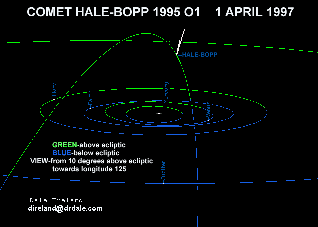
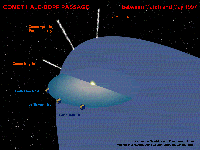
This comet will NOT hit the Earth.
![]()
How "big" is it?
![]()
Jets Coming from the Nucleus
![]()
How fast is Hale-Bopp's Nucleus Rotating?
![]()
What are the Hoods or Ripples Seen in Hale-Bopp's Coma?
(3/14/97)
![]()
How bright will it get in March and April, 1997?
It now seems likely that the peak brightness of the comet will be about magnitude
-0.8 magnitude). This means that the comet, which will look like a bright, fuzzy,
star with a tail low in the northwest sky in the evening, should be brighter than
any star in the evening sky except Sirius and the planet Mars. ![]()
What to expect:
![]()
What does it look like?
Images of the comet can be found here.
![]()
How Can You Find the Comet?
![]()
Finder Charts for Hale-Bopp
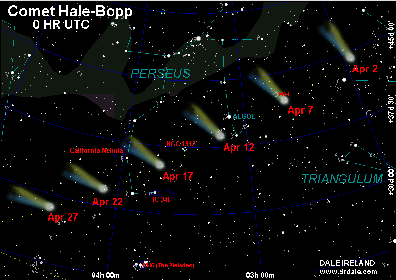



![]()
Viewing from the Southern Hemisphere

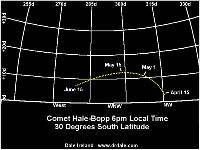
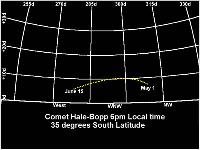
![]()
Comet Hale-Bopp and the Eclipse of March 9, 1997
![]()
Links to Other Hale-Bopp Home Pages
![]()
Little Green Men and Other Hoaxes
![]()
Go To:
![]() Comets Currently
Visible
Comets Currently
Visible
![]() Recent News and Observations
Recent News and Observations
![]() Comet Light Curves
Comet Light Curves
![]() Ephemerides for Current Visually Observable Comets
Ephemerides for Current Visually Observable Comets
![]() Comet Definitions
Comet Definitions
 Comet Images
Comet Images
![]() Other Pages Featuring Comet Images
Other Pages Featuring Comet Images
 Comet Observation Home Page
Comet Observation Home Page